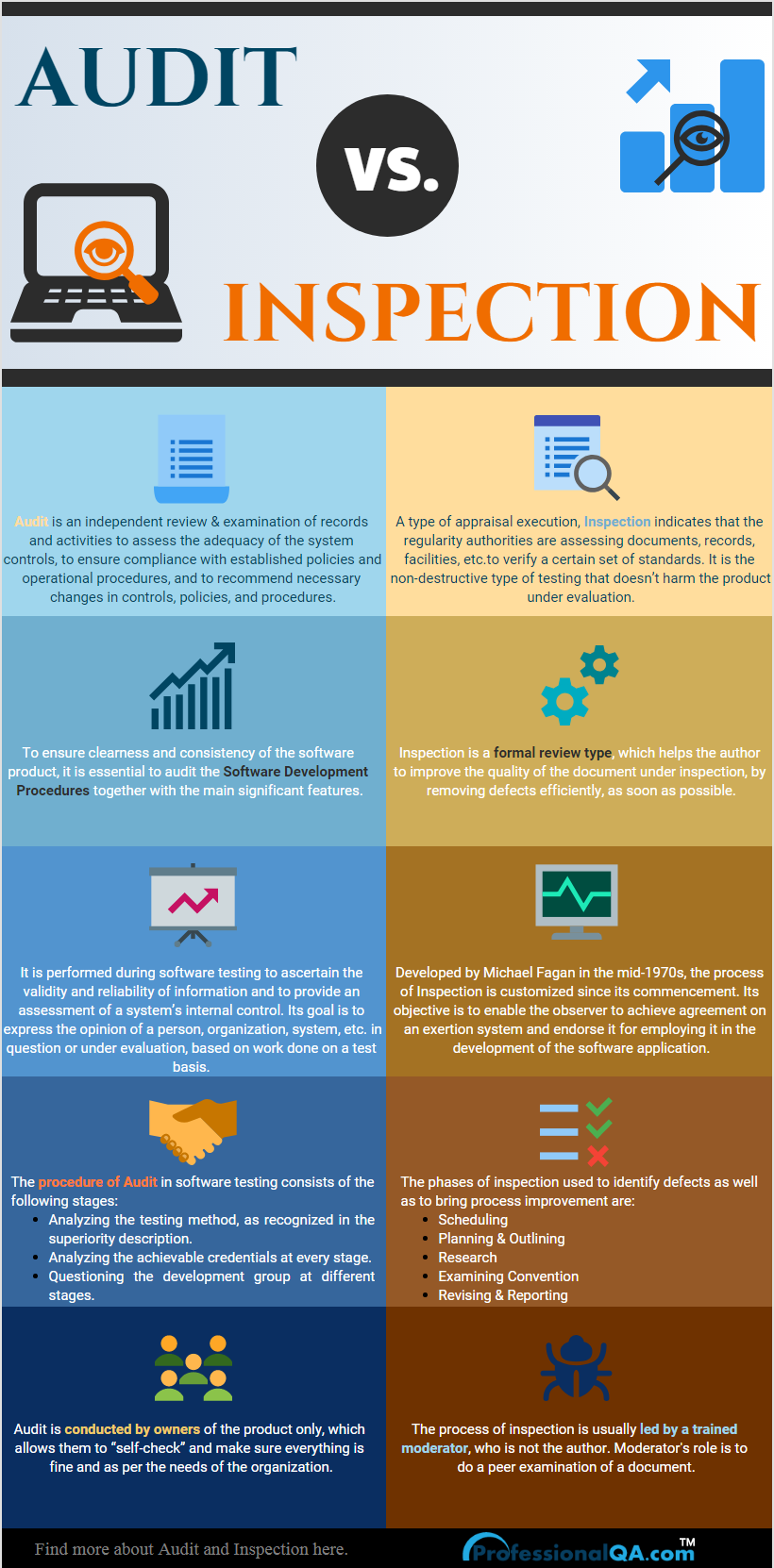

Software development is a complex process. It involves several tests and development activities, which aims at creating a product of superior quality that provides exceptional services. Software engineers use innovative and effective techniques to ensure that the product is created according to the clients demand and fulfils their needs accurately. Audit and Inspection are two parts of software development, which help testers and developers in monitoring the quality of the software. Moreover, both of these are immensely important and help the Quality Assurance (QA) team frequently.
Audit is an independent review and examination of records and activities to assess the adequacy of the system controls, to ensure compliance with established policies and operational procedures, and to recommend necessary changes in controls, policies and procedures. Whereas, Inspection indicates that the regularity authorities are checking documents, records, facilities, and any other authorities to verify a certain set of standards. To provide a better understanding of these two, following is a detailed comparison of Audit and Inspection.
To ensure clearness and consistency of the software product, it is essential to audit the Software Development Procedures together with the main significant features. It is a vital action in companies and helps them check for bugs in the system, which further validates the product quality and effectiveness. Audits are performed in software testing to ascertain the validity and reliability of information as well as to provide an assessment of a system’s internal control.
Its goal is to express an opinion of the person, organisation, system, etc., in question or under evaluation, based on work done on a test basis. Moreover, audit is conducted by owners of the product only, which allows them to “self-check” and make sure everything is fine and as per the needs of the organisation.

Auditing in software testing is essential as it aids organisations and comprehends if the progress is being followed and monitored perfectly. It allows testers to find any defects and errors in the system and ensures that product performance is of standard quality. Other benefits of auditing in software testing are mentioned below:
Auditing and test management ensure that software is being developed and deployed in accordance with company requirements. Organizations benefit from this pairing by gaining basic insight into day-to-day practices, including potential areas for improvement. The combination of technology and procedure puts applications in a context in which they can be accurately evaluated. Similarly, the procedure of Audit in software testing is extremely important and consists of various stages, which are described below:
In general the term Inspection means the process of evaluating or examining things. The output of inspection is compared with the set standard or specified requirement to check whether an item that is being developed is as per the requirement or not. It is the non-destructive type of testing and it doesn’t harm the product under evaluation. Inspection is a formal review type that is led by trained and expert moderators.
During the inspection the documents are prepare and checked thoroughly by the reviewers before the meeting. It involves peers to examine the product. Moreover, a separate preparation is carried out in Inspection, during which the product is examined and the defects are found. These defects found are documented in a logging list or issue log, after which a formal follow-up is carried out by the moderator applying exit criteria.
Inspection is a type of appraisal execution that is frequently used in software applications. The objective of inspection is to enable the observer to achieve agreement on an exertion system and endorse it for employing it in the development of the software application. Usually inspected job systems consist of software necessities definition and test designs. Other goals of Inspection are:
Developed by Michael Fagan in the mid-1970s, the process of Inspection is comprehensive and customized since its commencement. It includes accessing feature that conclude if the inspection method is prepared to be initiated. With the assistance of Inspection one can review the system which is going to be checked.
The phases in the inspections method include Scheduling, outline conference, Research, examination convention, revise and report-on. The Scheduling, outline conference and Research stages might be iterated. The characteristics that differentiate inspection from Audit are:
Reviewing and monitoring the product during software testing process is extremely essential and is frequently implemented by the software engineers all over the world, to ensure product quality and functionality. Audit and Inspection are two common methods of reviewing a software during the process of testing.
Even though both of these methods are used to review some elements during software testing, it is Inspection that is practised frequently by the testers. The goal of Audit is to usually assess overall compliance of the software with one or more regulations, internal policies, or other compliance drivers. Audits allows a company to “self-check”, which ensures that everything is fine and as per the needs of the organisation.
Inspection, on the other hand is a formal review type, which is used to indicate whether the regulatory authorities are checking documents, records, facilities and any other resources, to verify a certain set of standards. Hence, a software developer or tester can opt for any of these methods as per their requirement and validate the quality, effectiveness and performance of the end product.
Advertisement: